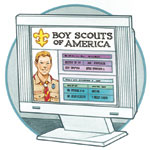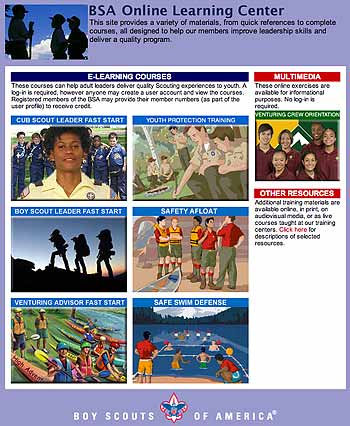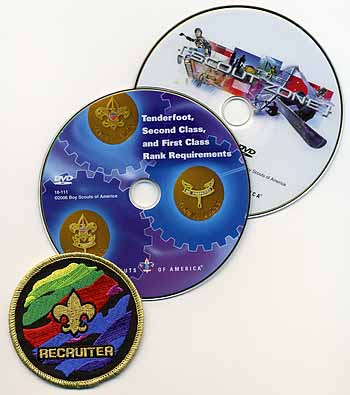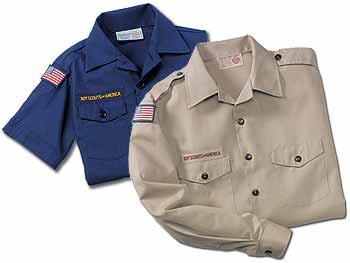
News Briefs
Special day celebrates winter sports
On Saturday, Jan. 6, more than 100 locations in the United States and Canada will participate in the 12th annual Winter Trails program, a free one-day event that introduces newcomers to snow sports via snowshoeing and cross-country skiing.
The event is organized by SnowSports Industries America, the American Hiking Society, and the Cross Country Ski Areas Association. Equipment is provided by venue or product suppliers. Information about locations and times is available at wintertrails.org.
Winter Trails is part of the Winter Feels Good campaign to promote health, fitness, and social benefits of snow sports participation (www.winterfeelsgood.com).
Leaders can take training online
New volunteer leaders in all Scouting programs can now take their initial Fast Start training at the BSA's Online Learning Center (OLC) at olc.scouting.org. (The center can also be accessed through many local council Web sites.)
 |
The OLC brings together essential volunteer learning in a single package, said Jerry Hasting, director of the Information Systems Division at national BSA headquarters. "The site allows unit leaders to take courses at their convenience at home; each course takes about an hour, and the volunteer can then download and print a certificate showing that he or she has successfully completed the training."
New volunteers need Fast Start training before beginning youth activities. The course covers such basics as the aims and purposes of the BSA, how to manage troop or den meetings and outdoor activities, job descriptions of various leadership positions, and additional sources of information.
In addition to Fast Start for Cub Scout, Boy Scout, and Venturing leaders, the OLC also offers Youth Protection Training (a new, interactive, more substantial version), Aquatics Safety (including Safety Afloat and Safe Swim Defense), and Venturing Crew Orientation.
Scouters who enter their official BSA registration number when accessing the OLC through a local council Web site can review their personal training histories in a permanent record that shows courses completed or started and the status of any unfinished courses.
"The online learning program allows local councils to offer new volunteers an easy, comfortable way to obtain information and skills they need to be successful leaders of young people," Hasting said. "And this is only the beginning. More courses will be added as they are developed."
—Bill Sloan
NUMBERS
90—The Erie Shores Council of Toledo, Ohio, celebrates the 90th anniversary of Camp Miakonda on June 2 at a special Heritage Day Exposition. Held at the camp, which first opened in 1917, the festive day will feature exhibits and demonstrations by council packs, troops, and crews, plus a wide variety of other activities.
87,300—First Aid merit badges earned by BSA Scouts in 2005, the most of any of the 121 available badges. Others in the top five merit badges in number earned in 2005 were Swimming (75,796), Environmental Science (67,852), Camping (62,393), and Citizenship in the World (61,746).
207,216—pounds of food collected by Scouts in the Miami Valley Council (Dayton, Ohio) in the 2006 Scouting for Food Good Turn, an increase of 18,000 pounds over the previous year. An additional 3,000 pounds were collected during a special "Fill a Bus" awareness event, using a bus provided by the Greater Dayton Regional Transit Authority. Ohio National Guard and Wright State University ROTC members assisted with the event.
Recruiting, Retention, and Advancement Tools Available for Leaders and Scouts
 |
A new set of troop membership and retention tools on DVD has been mailed from the national Boy Scout Division to all Scoutmasters.
The package includes videos that show:
- how to conduct successful recruitment meetings
- how to maximize Webelos to Scout transition
- how to train boys to recruit their friends (The DVD package also includes a sample Recruiter patch to be awarded to Boy Scouts who recruit a new Boy Scout.)
- what Scout parents are saying about successful BSA programs
- how to successfully complete requirements for Tenderfoot, Second Class, and First Class.
The set of short requirement instructional videos, narrated by boys of Scout age, are user friendly and highly informative. They allow Scouts working on the three ranks to see (and replay as needed) step-by-step instruction in such basic skills as how to pitch a tent, whip a rope, fold the U.S. flag, tie useful knots like two half hitches and a taut-line hitch, and perform the Heimlich maneuver.
In addition to the DVD format, the instructional videos are available online on the BSA national Web site, at http://www.scouting.org/boyscouts/rankvideo. They can be viewed at any time on the Web site or downloaded as a podcast for viewing on an iPod device.
New national initiative focuses on generating more parent involvement in Scouting
ScoutParents is part of a national parent initiative from the BSA to strengthen the retention of youth in Scouting by helping parents better understand the Scouting program, how it benefits their children, and how to become involved in the unit program in a leadership capacity.
The "parents" in ScoutParents includes not only mothers and fathers but also guardians and family members such as grandparents, aunts, uncles, and older brothers and sisters.
The new focus on parental involvement is designed for adaptation and implementation at local council, district, and unit levels. Pilot programs are currently being tested in the Daniel Boone Council, Asheville, N.C., and the Flint River Council, Griffin, Ga.
A Web site, www.scoutparents.org, has been developed as a resource. Using videos and other visual elements, the site provides parents with information on Scouting's history, organization, purpose, methods, and benefits. Also included is a discussion forum where visitors can post comments or ask questions.
Additional details and resources in support of involving more parents in a unit's program are available on the national BSA Web site, www.scouting.org.
New Pack Trainer Award available to those who mentor Cub Scout leaders
The Pack Trainer Award is the newest recognition available to Cub Scout leaders who complete specific training, tenure, and performance requirements. The award recognizes the important role the pack trainer performs in mentoring new adult leaders and families in their pack. Similar to other Cub Scout leader recognition awards, it is presented by the local council and is represented on the uniform by a square knot insignia worn above the left shirt pocket.
Requirements (BSA document No. 13-083) include serving two years as a registered pack trainer, completing specific training (including Fast Start, New Leader Essentials, and Youth Protection Training), and achieving designated levels of performance involving delivering, planning, and promoting training to pack leadership. (Scouters registered as pack trainers must use Sept. 1, 2006, as the start date for tenure and performance requirements.)
The five other Cub Scout leader recognition awards are the Tiger Cub Den Leader Award, Cub Scout Den Leader Award, Webelos Den Leader Award, Cubmaster Award, and Cub Scouter Award. Information on their requirements (BSA document No. 13-595) is available at council service centers and at http://www.scouting.org/cubscouts/resources/13-595.
Get the 2006 Scouting index
The 2006 Index for Scouting magazine and indexes for each year back to 1970 are available on the magazine's Web site at www.scoutingmagazine.org/about/pastissues.
Indexes are also available by mail. For one index, send a self-addressed, first-class-stamped, business-size envelope; for more than three, add additional postage.
Order indexes from Scouting Magazine Index, S304, 1325 W. Walnut Hill Ln., P.O. Box 152079, Irving, TX 75015-2079.
Recycling of 'experienced' uniforms helps needy Scouts
The Oregon Trail and Muskingum Valley Councils are half a continent apart, but each has established a highly successful Scout uniform recycling program to benefit needy youngsters, thanks to the efforts of hardworking local volunteers.
 |
In Eugene, Ore., longtime Scouter Jim Thomas is in his fifth year of operating a uniform bank that has provided 500 "experienced" Cub and Boy Scout uniforms for boys who otherwise might not be able to afford them.
"Jim is a one-man recycling machine," says Oregon Trails Scout Executive Michael S. Quirk. "He haunts garage sales and Goodwill, Salvation Army, and St. Vincent de Paul stores to locate and buy used uniforms, then removes all the old patches, launders them and makes them available to kids who need them. He's amazing."
"I don't charge for the uniforms," says Thomas, a former Cubmaster who is unable to work at a full-time job because of a heart condition, "but I do accept donations from those who can afford it."
Thomas passes out cards to potential donors of used uniforms wherever he goes. "I don't keep an exact count, but I've been able to help out about 100 boys a year," he says. "By late December I'm always running low on uniforms, so it's time to start over again."
In Zanesville, Ohio, meanwhile, Scout Executive John G. Harding credits veteran Scouter Richard Daley with originating a uniform buyback program in the Muskingum Valley Council that has provided more than 50 recycled shirts, as well as neckerchiefs and belts, for needy youth since it began in 2005.
"We pay between $5 and $10 for any used BSA shirt," said Harding. "We clean it, strip it of patches, and make any necessary repairs, then offer it to unit leaders for the same price we paid. All our Scouts and parents have been alerted to the need, and we've been able to help a number of deserving kids this way."
—B.S.
Council award for youth and leaders helps to get Scouting stories into the local media
It's no accident that community newspapers in the suburban Northeast Illinois Council seem to be carrying more news about local Scouts and Scouting programs these days. It's the result of a coordinated council campaign to build positive public relations—and council officials credit much of its success to an innovative news reporting award, an emblem any Scout or adult leader can earn by helping to spread the word about Scouting.
"We started the Scout News Reporter program three years ago, with the patch award as recognition," said Allen Hibnick, the council's director of operations. "The council encompasses 51 communities, each with its own local newspaper; and since these neighborhood papers prefer to publish stories about people and events within their coverage areas, we saw it as a great opportunity to publicize Scouting."
The council marketing committee developed a guidebook, Telling Scouting's Positive Story Through the Local Media, for distribution at roundtables and other training events. They also made the book—along with a list of local media contacts, a fact sheet on Scouting, and an application for the award—available in the Resources section of the council's Web site, www.neic.org.
"Any Scout or leader who gets a story published—either by writing, sending a news release, or contacting the paper and arranging for it to send a reporter or photographer—can earn the award," Hibnick explained. "All we require is a copy of the published article."
Recent patch-worthy efforts range from a Boy Scout in Troop 912 of Evanston, Ill., who contacted the Evanston Pioneer Press about a high adventure trip to Montana, resulting in a published story and photo, to a Cubmaster in Zion, Ill., who alerted the local newspaper about his pack's annual pinewood derby, and the paper ran a full page of photos of the event.
"So far, we've issued 166 patches and seen a lot more news stories published about what Scouts are doing," said Hibnick. "Besides rewarding individuals for published positive stories, the program has also encouraged many units to form PR committees that work year-round on getting stories about their activities into their local news media."
—B.S.
(Contributing editor Bill Sloan offers tips on getting Scouting news into local media; read "Telling Scouting's Positive Story" at www.scoutingmagazine.org/issues/0111/a-publ.html.)
Share extra copies of Scouting
If your household receives more than one copy of Scouting magazine and you don't need the additional copy, we suggest donating it to one of the following: a neighbor, friend, or co-worker; a school, church, or Scout unit library; a barbershop, hospital, or physician's or dentist's office; or your workplace reception area.
January - February 2007 Table of Contents
Copyright © 2007 by the Boy Scouts of America. All rights thereunder reserved; anything appearing in Scouting magazine or on its Web site may not be reprinted either wholly or in part without written permission. Because of freedom given authors, opinions may not reflect official concurrence.